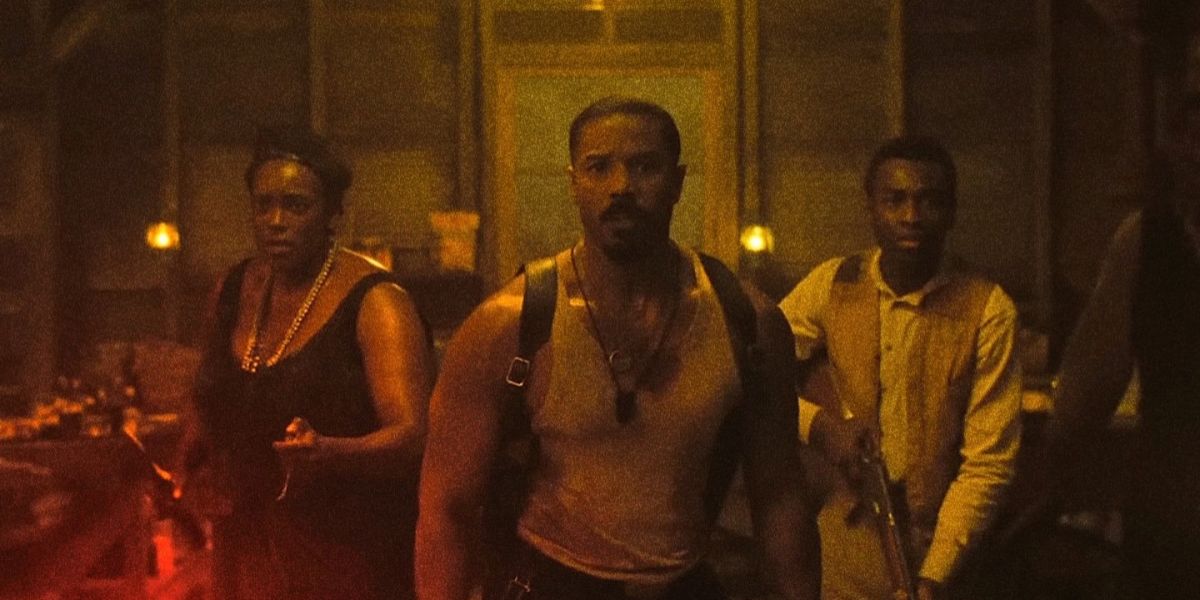Vampires? In the South? Running a juke joint?
Sounds like the setup for a strange but possibly iconic Halloween party.
Except the Sinners film isn’t really a vampire story at all. It covers something a lot scarier—and a lot more real.
Beneath the blood and fangs, it hides a sharp, gut-punching metaphor about trust, betrayal, and the dangers of believing too hard in smiling faces.
And while a lot of people have picked up on the film’s commentary about cultural exploitation, there are two things I haven’t seen many people talk about yet—and they completely change how I see the story:
- How trust, even with the best intentions, can be weaponized against your own community.
- The possibility that the vampire attack… may never have happened at all.
Let’s sink our teeth into this masterpiece. 🧛♂️
The Surface Story: Vampires and the American South
This is a story of twin brothers Smoke and Stack (both played by the handsome Michael B. Jordan), who traveled back to their hometown in Mississippi after having stolen money from gangsters in Chicago.
They came back with real cash—not plantation money—and knew exactly how to spend it: opening a local juke joint.
However, the man who sold it to them, Remmick, was a bit suspicious. He questioned their intentions with the property and had mopped the floors a little too thoroughly.
Nevertheless, they sealed the deal.
Opening night was the best day of their lives. They invited the entire town—childhood friends who felt more like family—to sing and dance to the Blues.
A special guest of theirs, their little cousin Sammie, was a passionate Blues musician. They asked him to play, and he was amazing.
In fact, his music was so pure, so moving, that he attracted the spirits of his ancestors, other cultures, and even musicians of the future.
This scene was particularly striking—I wouldn’t be surprised if it won Ryan Coogler (the director) a few awards.
Fangs of Envy
Their joy would soon come to a sharp halt when the soul-heavy music attracted evil spirits as well: vampires, to be specific.
The three bloodsuckers, a couple of KKK members and an Irishman, approached the juke joint and asked the doorman to let them inside to play some music. He consulted with Smoke and Stack, who refused for fear of trouble.
The three declared they would walk away very slowly, in case the twins changed their minds.
Thoroughly creeped out, the group went back to partying, but it wasn’t long before they realized those who went outside came back in transformed into something else.
At this point, the carnage began.
One by one, their beloved friends were turned into vampires, dancing in fellowship with the three initial vampires.
It didn’t end well—only Smoke and Sammie survived, having lured the pack of vampires into the sun.
The next day, Smoke sat prepared in the forest, expecting the previous owner Remmick to arrive with his KKK buddies to ambush them.
He was right. And he killed them off one by one.
Let’s take a deeper look into the meaning behind all this.
Vampires as White Exploiters of Black Culture
The Sinners film is no vampire story.
Instead, it depicts bigots like KKK members and other exploiters as bloodsucking thieves, who take advantage of Black culture and appropriate it, all while mistreating its originators.
It illustrates how White America has fed off Black talent, culture, and soul for centuries, and how it feels to those who suffer this abuse.
Sammie, the Blues singer, reflects the experience of many Black musicians who simply want to make music, but encounter exploitation and disrespect at the hands of the White-owned industry.
These supremacists give off an illusion of allyship, smiling so big you wouldn’t even notice the drool running down their chin. Their kindness is fueled by little more than greed, superiority and ambition.
On the other hand, many Black artists who avoid certain Black issues out of loyalty to their White bosses, are considered sell-outs for wasting the opportunity to speak out for their community.
This leads us to the next theory.
Toxic Trust: How Stack’s Kindness Backfired
The most interesting character in the Sinners film may have been Stack, the kinder, more trusting of the two brothers.
He’d fallen in love with a White woman who had good intentions. She was considered family, and hadn’t caused any trouble since they met. However, he didn’t feel it was safe for them to be together.
This relationship alone made Stack generally trusting and forgiving toward White people.
However, that all changed when the ill-intentioned vampires paid them a visit.
When the twins realized their juke joint would go broke after a few months running only on plantation money (the money their Black friends could offer), Stack believed it may be a good idea to invite the White musicians in.
Mary, seen as the safest bridge between the two worlds, was the one he trusted to approach them.
But when she went outside to speak with the group, they turned her into their first victim, setting off a chain reaction that would destroy the entire community.
Innocence Hijacked
This can be seen as a metaphor: Unfortunately, even well-intentioned individuals can become a liability when associating with both sides: the exploited and their exploiter peers.
In a way, simply by having invited Mary into their community, they brought danger upon themselves. Had she not attended the party that night, or remained in Stack’s life, they all would’ve survived.
It’s the unfortunate, brutal truth behind it all.
By exploiting the Black community, White supremacists hurt not only their direct victims, but also those of their own race. Hatred is a self-destructive cycle.
And tragically, once infected, Stack and Smoke’s other friends became unwitting instruments of their community’s destruction, dancing alongside the very oppressors who sought to consume them.
However, after having peeled back the layers of that fated vampire scene, it made me wonder… Did it even happen in the first place?
Theory: The Vampire Scene Never Actually Happened
What happened to Smoke and Sammie, the two survivors, was too evil to comprehend; a violation of trust, community, culture, and humanity.
But what really happened that fateful night?
In their version, Smoke faces Remmick’s KKK group the next day in a massive shoot-off.
Strangely, he seemed a bit too prepared—like he was certain they would attack. But if that were the case, why would he and Stack buy the property in the first place?
Their decision to open the juke joint suggests they believed, at least for a moment, in the possibility of peace. Or, they were willing to risk it for a chance at prosperity.
During the vampire raid as well, two of the bloodsuckers belonged to the Klan.
What if the carnage wasn’t a vampire attack at all, but a shoot-off where everyone was killed? After all, the twins had mentioned they never retrieved their trunk full of weapons—their only real defense.
The oppressors came to enjoy their culture, drawn in by pure, soulful music—only to end the night in slaughter.
It wouldn’t be difficult for the victims to perceive the attack as a vicious group of bloodsuckers, come to feed.
The film seemed to constantly shift between realism and horror, mythologizing pain to make it easier to express.
It’s easier to believe in monsters than neighbors turned executioners.
Why This Film Matters
The Sinners film is more than horror—it’s history dressed as horror.
And more importantly, it offers a clear, timely window into the monstrosities of racism, betrayal, bigotry, and cultural theft.
It warns of the hidden dangers of trust and performative kindness, and how exploitation can disguise itself as opportunity.
What makes this film truly terrifying is that the real monsters don’t wear fangs—they’re very real, dressed in smiles, suits, and handshakes.
And they leave widespread devastation in their wake.
What do you think really happened in the Sinners film? Leave your thoughts below. Let’s discuss!


Leave a Reply